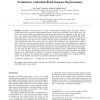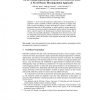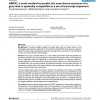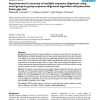441 search results - page 1 / 89 » Novel structures in Stanley sequences |
BMCBI
2005
13 years 10 months ago
2005
Background: The sequencing of the human genome has enabled us to access a comprehensive list of genes (both experimental and predicted) for further analysis. While a majority of t...
JCC
2008
13 years 10 months ago
2008
: Knowledge of structural classes is useful in understanding of folding patterns in proteins. Although existing structural class prediction methods applied virtually all state-of-t...
ICA
2012
Springer
12 years 6 months ago
2012
Springer
A novel tensor decomposition called pattern or P-decomposition is proposed to make it possible to identify replicating structures in complex data, such as textures and patterns in ...
BMCBI
2005
13 years 10 months ago
2005
Background: Currently available methods to predict splice sites are mainly based on the independent and progressive alignment of transcript data (mostly ESTs) to the genomic seque...
BMCBI
2006
13 years 11 months ago
2006
Background: Multiple sequence alignment (MSA) is a useful tool in bioinformatics. Although many MSA algorithms have been developed, there is still room for improvement in accuracy...




